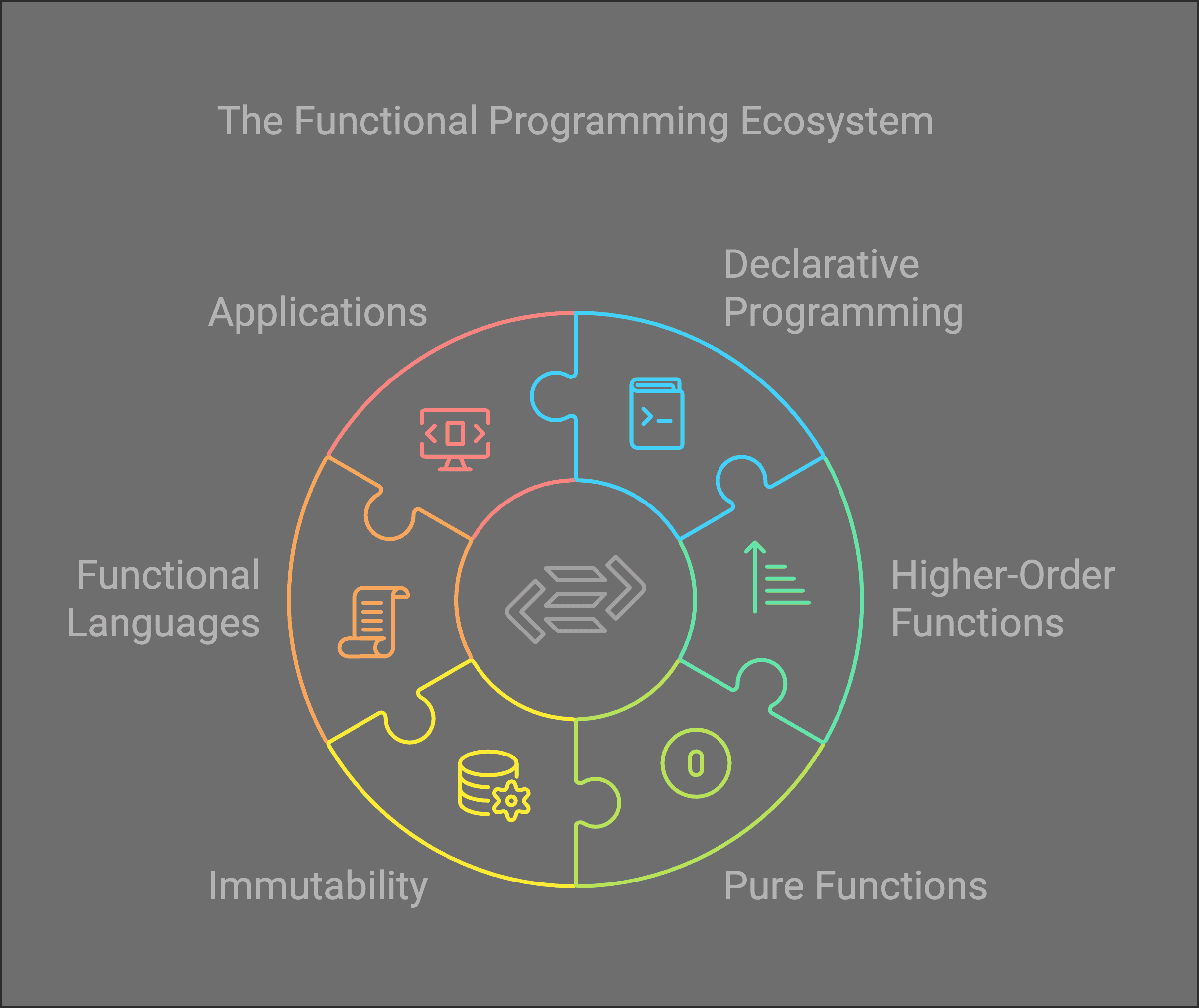Introduction to Functional Programming: Concepts and Applications

Discover the fundamentals of functional programming, a paradigm focused on immutability, pure functions, and declarative programming. Learn how it enables clean, scalable, and efficient software development, and explore key languages like Haskell, Scala, and Elixir alongside real-world applications in concurrent systems, real-time data processing, and web development.
Functional programming is a paradigm that has gained prominence in modern software development due to its focus on creating cleaner, modular, and more maintainable code. Unlike other paradigms, functional programming emphasizes the use of higher-order functions, immutability, and recursion, promoting declarative programming to efficiently solve complex problems. This article explores the fundamental concepts of functional programming, its key characteristics, supporting languages, and its diverse applications in software development.
1. Functional Programming

Functional Paradigm and Declarative Programming
Functional programming is a paradigm that stands out for its emphasis on declarative programming, where code describes what should be done rather than how to do it. This contrasts with imperative programming, which focuses on command sequences and state changes. In functional programming, functions are first-class citizens, meaning they can be assigned to variables, passed as arguments, and returned as results.
Higher-Order Functions
A defining feature of functional programming is the use of higher-order functions. These are functions that can take other functions as arguments or return them as results. This concept enhances abstraction and code reuse, enabling the creation of more flexible and modular components.
Lazy Evaluation and Recursion
Lazy evaluation is a technique where expressions are not evaluated until their value is required. This can significantly improve performance by avoiding unnecessary computations and enabling the creation of infinite data structures. Recursion, on the other hand, is a fundamental strategy in functional programming for iterating over data structures, replacing traditional loops used in other paradigms.
2. Pure Functions
No Side Effects and Determinism
Pure functions are the cornerstone of functional programming. A pure function always produces the same result for a given set of inputs without causing side effects. This ensures deterministic behavior, making functions predictable and easier to test and maintain.
Functional Purity and Referential Transparency
Functional purity ensures that functions neither depend on nor modify global state, promoting referential transparency. This property allows functions to be replaced with their return values without altering the program's behavior, improving code readability and reliability.
Code Reusability
Code reusability is another significant advantage of pure functions. By not relying on external states and being highly modular, pure functions can be reused in different contexts without introducing errors, accelerating development and reducing maintenance complexity.
3. Immutability
Immutable Data and Persistent Data Structures
Immutability is a fundamental principle in functional programming, stating that data should not be modified once created. Instead, new data structures are derived from existing ones. Persistent data structures make this possible by maintaining previous versions of data without altering them, facilitating change tracking and debugging.
Immutable State and Mutation-Free Programming
Maintaining an immutable state means that variables do not change their value once assigned. This contrasts with imperative programming, where variables can be mutated over time. Mutation-free programming significantly reduces errors related to shared state and race conditions, enhancing concurrency safety and making code easier to understand and maintain.
Concurrency Safety
Immutability contributes to greater concurrency safety by eliminating the possibility of multiple threads modifying the same state simultaneously. This simplifies the design of concurrent and distributed systems by removing the need for complex synchronization mechanisms to prevent state conflicts.
4. Functional Languages
Haskell
Haskell is one of the most well-known functional languages, renowned for its functional purity and strong type system. Haskell encourages writing pure code and uses lazy evaluation by default, enabling developers to build highly abstract and efficient programs.
Erlang
Erlang is a functional language designed for creating concurrent and distributed systems. Its robustness and fault-tolerance capabilities make it ideal for telecommunications and other applications requiring high availability and scalability.
Scala
Scala combines features of functional programming and object-oriented programming, offering flexibility that allows developers to use both paradigms depending on project needs. Scala runs on the JVM, facilitating integration with existing Java ecosystems.
Elixir
Elixir is a functional language that runs on the Erlang virtual machine (BEAM). It is designed for building scalable and maintainable applications, particularly in high-concurrency environments like web applications and distributed systems.
Clojure
Clojure is a modern functional language that runs on the JVM. Its design promotes concurrent programming and immutability and stands out for its simplicity and expressive power, enabling developers to write concise and efficient code.
5. Applications of Functional Programming
Scalable Software Development
Functional programming is ideal for scalable software development, as its principles of immutability and pure functions facilitate the creation of systems that can grow efficiently without introducing complex state-related errors.
Concurrent Applications
Concurrent applications benefit greatly from functional programming due to its focus on immutability and the absence of side effects. This ensures the safe execution of multiple processes simultaneously without state conflicts, improving performance and reliability.
Real-Time Data Processing
Functional programming is particularly suitable for real-time data processing, as it enables efficient and reactive data flow management. Pure functions and lazy evaluation make it easier to build data pipelines that can process large volumes of information quickly and reliably.
Distributed Systems Development
In distributed systems development, functional programming offers significant advantages in modularity and scalability. Immutability and referential transparency simplify the creation of components that can be deployed and managed independently, enhancing the system's robustness and flexibility.
Functional Web Applications
The development of functional web applications has gained popularity thanks to frameworks and libraries that support the functional paradigm. These frameworks allow the construction of reactive and highly maintainable user interfaces, leveraging functional programming to efficiently handle state and interactions.
Final Thoughts
Functional programming represents a significant evolution in software development, offering a cleaner, modular, and safer approach to building complex applications. Its principles of immutability, pure functions, and declarative programming not only improve code quality but also facilitate the construction of scalable and maintainable systems. Languages like Haskell, Erlang, Scala, Elixir, and Clojure demonstrate the power and versatility of this paradigm, enabling developers to tackle modern challenges with elegant and efficient solutions.
As technology continues to advance, the adoption of functional programming in areas such as concurrent applications, real-time data processing, and distributed systems will continue to grow, cementing its place as an indispensable tool in the software developer's arsenal. For those seeking to enhance their skills and stay at the forefront of software development, mastering functional programming is a valuable investment with significant rewards in quality, efficiency, and innovation.
